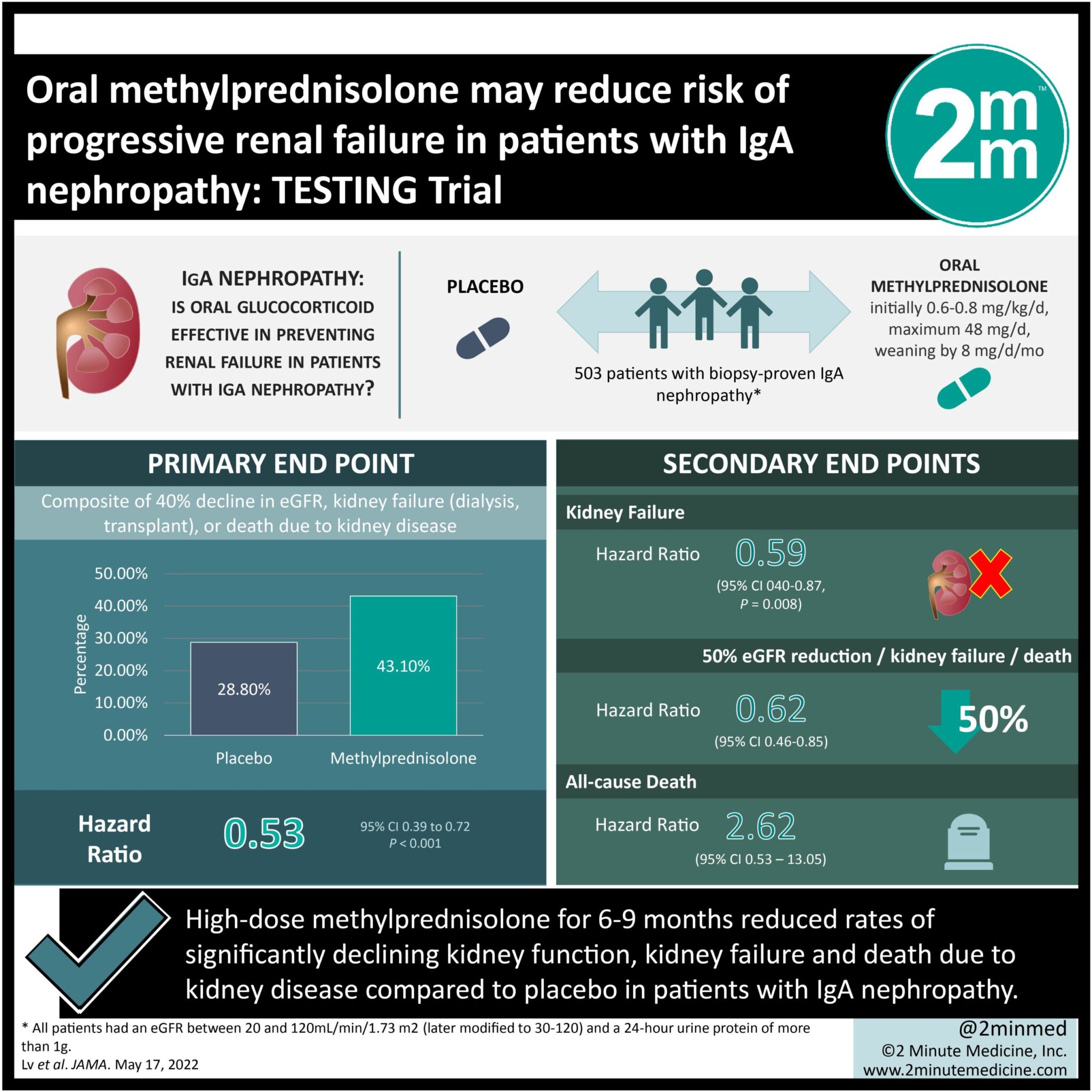1. This randomized controlled trial found that high dose methylprednisolone for 6-9 months reduced rates of significantly declining kidney function, kidney failure and death due to kidney disease compared to placebo in patients with IgA nephropathy.
2. Significant morbidity was associated with high dose methylprednisolone use.
Level of Evidence Rating: 1 (Excellent)
Study Rundown: IgA nephropathy remains poorly understood despite being the most common primary glomerular disease. Glucocorticoids are commonly used in clinical practice to manage IgA nephropathy, although the evidence in support of this is controversial, particularly with regards to the risk of immunosuppression in patients with advanced kidney disease. The present randomized controlled trial sought to determine the effect of oral methylprednisolone on renal function and related outcomes in patients with IgA nephropathy. The TESTING randomized controlled clinical trial consisted of 503 patients randomized with 257 in the treatment group and 246 in the placebo group. Mean baseline characteristics of the enrolled group included an estimated glomerular filtration rate (eGFR) of 61.5mL/min/1.73m2 and 24-hour urine protein of 2.46g/day. 74 primary outcome events (7.3% per year) occurred in the treatment group and 106 (12.1% per year) occurred in the placebo group; this difference was significant in favor of the methylprednisolone group. The treatment group fared better in all kidney-related outcomes; however there was an increased rate of adverse events (i.e., serious infections) in this group and all-cause mortality was particularly higher prior to the methylprednisolone dose reduction. This randomized controlled trial concluded that high dose methylprednisolone administered over a 6-9 month period may be protective against progressive kidney failure in the setting of IgA nephropathy. However, high dose glucocorticoids were associated with significant adverse effects and must be used with caution. Strengths of this study include the large sample size and diverse study population which make it more feasible to apply these results to the general population of IgA nephropathy patients. Additionally, the randomized controlled trial study design does well to minimize risk of bias, particularly confounding bias. A primary limitation of this work is the dose reduction which took place midway through the trial for safety reasons, which although necessary may have reduced the efficacy of blinding and certainly reduced trial consistency.
Click here to read this study in JAMA
Click here to read an accompanying editorial in JAMA
In Depth [randomized controlled trial]: This study is a placebo-controlled, double-blinded randomized controlled trial known as the Therapeutic Effects of Steroids in IgA Nephropathy Global (TESTING) study. Several centers around the world were involved in data collection. Of note, the original trial protocol was modified three years after the initiation of the study for safety reasons: more than 200 participants had developed severe infections on high dose methylprednisolone and in lieu of this, new participants were recruited to receive a lower dose of the study drug. Eligible participants had biopsy-proven IgA nephropathy, an eGFR between 20 and 120mL/min/1.73 m2 (later modified to 30-120) and a 24 hour urine protein of more than 1g. Patients were ineligible if they were considered unsafe to receive glucocorticoid therapy as assessed by their physician. All included patients participated in a health optimization period of 3 months prior to randomization (i.e., ensuring medication compliance). Participants received either 0.6-0.8mg/kg/day (max. 48mg/day) of methylprednisolone per day for 2 months which was tapered over the following 4-6 months or placebo; notably, the reduced-dose protocol prescribed 0.4mg/kg/day (max. 32mg/day). The composite primary outcome was achieved with one of the following: a 40% reduction in eGFR, kidney failure or death due to kidney disease. The hazard ratio for the primary outcome in the intervention versus control group was 0.53 (95% confidence interval 0.39 to 0.72); p<0.001. Hazard ratios and 95% confidence intervals for a number of secondary outcomes are as follows: kidney failure (0.59; 0.40-0.87, p 0.008); 50% eGFR reduction/kidney failure/death (0.62; 0.46-0.85); all cause death (2.62; 0.53 to 13.05). Finally, the difference in the mean rate of eGFR decline was 2.46 (0.94 to 3.99) favoring the treatment group across all study visits (p=0.002). The serious adverse event rate reported in the high dose methylprednisolone group was 10.9% compared to 2.8% in the placebo group. 78% of the serious adverse events occurring in the methylprednisolone group occurred prior to the dose reduction.
©2022 2 Minute Medicine, Inc. All rights reserved. No works may be reproduced without expressed written consent from 2 Minute Medicine, Inc. Inquire about licensing here. No article should be construed as medical advice and is not intended as such by the authors or by 2 Minute Medicine, Inc.



